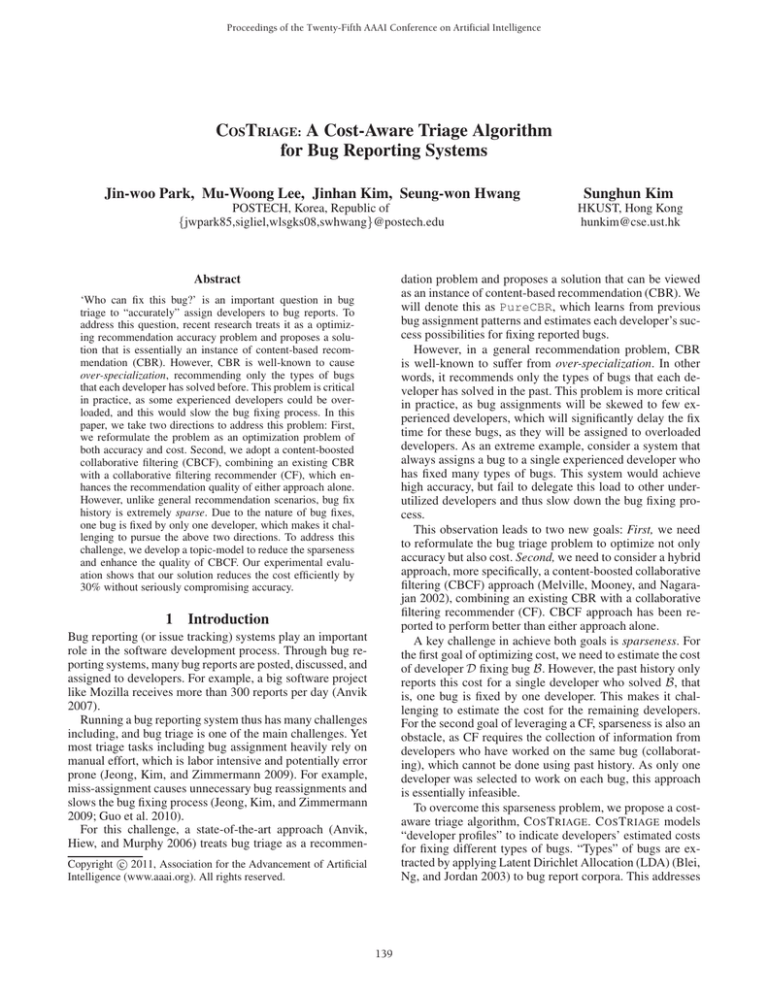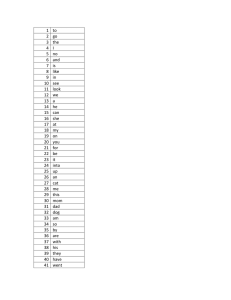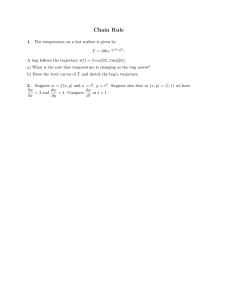
Proceedings of the Twenty-Fifth AAAI Conference on Artificial Intelligence
COSTRIAGE: A Cost-Aware Triage Algorithm
for Bug Reporting Systems
Jin-woo Park, Mu-Woong Lee, Jinhan Kim, Seung-won Hwang
Sunghun Kim
POSTECH, Korea, Republic of
{jwpark85,sigliel,wlsgks08,swhwang}@postech.edu
HKUST, Hong Kong
hunkim@cse.ust.hk
dation problem and proposes a solution that can be viewed
as an instance of content-based recommendation (CBR). We
will denote this as PureCBR, which learns from previous
bug assignment patterns and estimates each developer’s success possibilities for fixing reported bugs.
However, in a general recommendation problem, CBR
is well-known to suffer from over-specialization. In other
words, it recommends only the types of bugs that each developer has solved in the past. This problem is more critical
in practice, as bug assignments will be skewed to few experienced developers, which will significantly delay the fix
time for these bugs, as they will be assigned to overloaded
developers. As an extreme example, consider a system that
always assigns a bug to a single experienced developer who
has fixed many types of bugs. This system would achieve
high accuracy, but fail to delegate this load to other underutilized developers and thus slow down the bug fixing process.
This observation leads to two new goals: First, we need
to reformulate the bug triage problem to optimize not only
accuracy but also cost. Second, we need to consider a hybrid
approach, more specifically, a content-boosted collaborative
filtering (CBCF) approach (Melville, Mooney, and Nagarajan 2002), combining an existing CBR with a collaborative
filtering recommender (CF). CBCF approach has been reported to perform better than either approach alone.
A key challenge in achieve both goals is sparseness. For
the first goal of optimizing cost, we need to estimate the cost
of developer D fixing bug B. However, the past history only
reports this cost for a single developer who solved B, that
is, one bug is fixed by one developer. This makes it challenging to estimate the cost for the remaining developers.
For the second goal of leveraging a CF, sparseness is also an
obstacle, as CF requires the collection of information from
developers who have worked on the same bug (collaborating), which cannot be done using past history. As only one
developer was selected to work on each bug, this approach
is essentially infeasible.
To overcome this sparseness problem, we propose a costaware triage algorithm, C OS T RIAGE. C OS T RIAGE models
“developer profiles” to indicate developers’ estimated costs
for fixing different types of bugs. “Types” of bugs are extracted by applying Latent Dirichlet Allocation (LDA) (Blei,
Ng, and Jordan 2003) to bug report corpora. This addresses
Abstract
‘Who can fix this bug?’ is an important question in bug
triage to “accurately” assign developers to bug reports. To
address this question, recent research treats it as a optimizing recommendation accuracy problem and proposes a solution that is essentially an instance of content-based recommendation (CBR). However, CBR is well-known to cause
over-specialization, recommending only the types of bugs
that each developer has solved before. This problem is critical
in practice, as some experienced developers could be overloaded, and this would slow the bug fixing process. In this
paper, we take two directions to address this problem: First,
we reformulate the problem as an optimization problem of
both accuracy and cost. Second, we adopt a content-boosted
collaborative filtering (CBCF), combining an existing CBR
with a collaborative filtering recommender (CF), which enhances the recommendation quality of either approach alone.
However, unlike general recommendation scenarios, bug fix
history is extremely sparse. Due to the nature of bug fixes,
one bug is fixed by only one developer, which makes it challenging to pursue the above two directions. To address this
challenge, we develop a topic-model to reduce the sparseness
and enhance the quality of CBCF. Our experimental evaluation shows that our solution reduces the cost efficiently by
30% without seriously compromising accuracy.
1 Introduction
Bug reporting (or issue tracking) systems play an important
role in the software development process. Through bug reporting systems, many bug reports are posted, discussed, and
assigned to developers. For example, a big software project
like Mozilla receives more than 300 reports per day (Anvik
2007).
Running a bug reporting system thus has many challenges
including, and bug triage is one of the main challenges. Yet
most triage tasks including bug assignment heavily rely on
manual effort, which is labor intensive and potentially error
prone (Jeong, Kim, and Zimmermann 2009). For example,
miss-assignment causes unnecessary bug reassignments and
slows the bug fixing process (Jeong, Kim, and Zimmermann
2009; Guo et al. 2010).
For this challenge, a state-of-the-art approach (Anvik,
Hiew, and Murphy 2006) treats bug triage as a recommenc 2011, Association for the Advancement of Artificial
Copyright Intelligence (www.aaai.org). All rights reserved.
139
the sparseness problem and enhances the recommendation
quality of CBCF.
Using developer profiles, whenever a new bug is reported,
we first determine the type of the bug, and obtain each developer’s estimated cost for the bug. Then by combining the
cost with the possibilities estimated by PureCBR, we rank
the developers and assign the first developer to the bug.
We experimentally evaluate C OS T RIAGE using four reallife bug report corpora1,2,3,4 , in comparison with two baselines: (1) PureCBR, and (2) CBCF. Our experimental results
show that C OS T RIAGE significantly reduces cost, without
seriously significantly sacrificing accuracy.
2
1. For each developer, a support vector machine (SVM) classifier is trained using the bug features from the bugs fixed
by the developers and the time spent to fix that as the class.
2. When a new bug B is reported, developers’ cost vector LC
is estimated. An empty column for B is inserted to HC ,
and each empty cell of HC is filled with the pseudo cost
estimated by the corresponding classifier trained in the
first step. We then apply column-column CF (developerdeveloper CF) to HC , to revise the pseudo costs of B.
3. PureCBR is performed to obtain the vector LS of developers’ success possibilities.
4. LC and LS are merged into one vector LH . Developers
are ranked in descending order of LH , then the first developer is assigned to B.
The first and the second steps of the procedure exactly
follow Melville’s CBCF algorithm (Melville, Mooney, and
Nagarajan 2002).
In the rest of the paper, we will denote this four-step approach as CBCF.
Approach
To pursue the dual goals of accuracy and cost, we use two
historical datasets HF and HC . HF consists of the pairs of
F (B), D, where F (B) is the feature vector of a given bug
B, and D is the developer who fixed B. HC is an m-byn matrix of costs for m developers and n fixed bugs. As a
proof-of-concept, we use bug fix time as cost.
For a reported bug, using HF , we identify who can fix
the bug. Meanwhile, using HC , we find how much it will
cost for each developer to fix the bug. Finally, combining
the both results, we rank the developers and choose one to
be assigned.
2.1
Merging LC and LS When we reach the last step, LC and
LS are merged as follows. Formally, LC and LS are:
LC = sC[1] , sC[2] , · · · , sC[n] , LS = sS[1] , sS[2] , · · · , sS[n] ,
where sC[i] means the ith developer’s estimated cost to fix
the given bug B, and sS[i] denotes the ith developer’s success
possibility for fixing B, obtained by PureCBR.
To merge the vectors and obtain a hybrid score vector LH ,
Baseline I: PureCBR
Anvik’s algorithm (Anvik, Hiew, and Murphy 2006),
PureCBR, considers bug triage as a multi-class classification problem, and utilizes only HF . For each data record in
HF , F (B) is the set of keywords extracted from the title,
descriptions, and other metadata contained in the bug report
B. The developer D, who actually fixed this bug, is the class
of this data record.
After training a multi-class classifier, when a new bug
is reported, PureCBR estimates each developer’s score for
the new bug by extracting its feature vector and applying
the classifier. PureCBR simply picks the developer with the
highest score to assign the reported bug. It thus neglects the
costs of developers to fix the bug.
2.2
LH = sH[1] , sH[2] , · · · , sH[n] ,
a hybrid score sH[i] of a developer is computed as a weighted
arithmetic mean of the normalized sS[i] and sC[i] :
sS[i]
1/sC[i]
+ (1 − α) ·
, (1)
max(LS )
1/ min(LC )
where 0 ≤ α ≤ 1. In Equation 1, we take the inverse of
sC[i] because a small sC[i] value means high performance,
i.e., short estimated time to fix B. Both sS[i] and 1/sC[i] are
normalized to have a maximum value of 1. This hybrid computation involves one control parameter, α, to trade-off accuracy with cost.
sH[i] = α ·
Baseline II: CBCF
Adopting PureCBR is a sufficient solution to utilize HF ,
but it disregards HC . We need to utilize both HF and HC .
For a new reported bug B, to be cost aware, we estimate each developer’s cost for fixing B. Even though this
problem seems to be related to CF problems, pure CF algorithms do not work for bug triage data, because we have no
known cost for fixing B. However, by training one classifier
of cost for each developer, CBR or CBCF can be applied.
We choose to apply CBCF because it outperforms CBR in
general (Melville, Mooney, and Nagarajan 2002).
To combine CBCF-based cost estimation with PureCBR,
we introduce the following four-step hybrid procedure:
2.3 Proposed Approach: C OS T RIAGE
CBCF tries to utilize both accuracy and cost. However CBCF
has room for improvement, because bug fix history is extremely sparse. We thus devise developer profiles, which
are compact and unsparse. Our new triage algorithm, C OS T RIAGE, basically follows the four steps of CBCF, but we
replace the first two steps with a new procedure using the
developer profiles.
Constructing Developer Profiles A developer profile is a
numeric vector, in which each element denotes the developer’s estimated cost for fixing a certain bug type. The bug
type means that if some bugs belong to the same type, these
bugs share very similar features. More formally, a developer
profile Pu is a T -dimensional vector of numeric scores pu[i] :
Apache, https://issues.apache.org/bugzilla/
Eclipse, https://bugs.eclipse.org/bugs/
3
Linux kernel, https://bugzilla.kernel.org/
4
Mozilla, https://bugzilla.mozilla.org/
1
2
Pu = pu[1] , pu[2] , · · · , pu[T ] ,
140
(2)
Table 1: An LDA model of bug reports for Mozilla. T = 7. Top-10 representative words with the highest probabilities.
Topic 1
c
0.058
line
0.058
cpp
0.040
int
0.032
mozilla
0.032
src
0.026
const
0.023
unsigned 0.020
bytes
0.019
builds
0.018
Topic 2
mozilla
0.047
firefox
0.024
add
0.014
version
0.010
update
0.010
thunderbird 0.010
file
0.008
files
0.008
added
0.007
install
0.007
Topic 3
js
0.028
error
0.018
mozilla
0.018
file
0.014
test
0.011
function 0.011
ns
0.010
c
0.010
chrome
0.009
content
0.009
Topic 4
window 0.023
page
0.019
click
0.016
menu
0.014
button
0.013
open
0.013
text
0.012
dialog
0.010
select
0.009
search
0.009
where pu[i] denotes the developer’s cost for ith -type bugs
and T denotes the number of bug types.
To model developer profiles, we need to address two major problems: (1) how to categorize bugs to determine bug
types, and (2) how to obtain the profile of each developer.
Categorizing Bugs: One naive way to define types of bugs
is to assume that each reported bug belongs to its own specific type. This means that if N distinct bugs have been reported, N types of bugs exist, i.e., T = N . Clearly this
approach is not desirable for our problem, because the dimensionality of the profiles would be both too large and unbounded. Therefore, we devise a method to define a small
and limited number of bug types, adopting LDA.
The basic idea of LDA is that a document is a mixture of
latent topics, and that each topic is characterized by a distribution of words. For a given number of topics T and a
corpus of documents, where each document is a sequence
of words, LDA extracts T topics from the corpus. After the
topics are extracted, the LDA model of these topics can be
used to determine the distribution of topics for each document.
To apply LDA, one main question is “what is the natural
number of topics in a corpus?” Although it may be explicitly answered, obtaining such information is often difficult.
To address this challenge, we adopt Arun’s divergence measure (Arun et al. 2010), because it has more robust behaviors
than others (Cao et al. 2009; Zavitsanos et al. 2008).
In the context of bug reports, for using LDA, each bug
report can be considered as a document, which consists of
words that are explicitly stated in bug reports. Table 1 illustrates an LDA model of 48,424 Mozilla bug reports.
Each topic in an LDA model is represented as probabilities that words will occur. For instance, Topic 1 of the
Mozilla project consists of 5.8% c, 5.8% line, 4.0% cpp,
3.2% int, and 3.2% mozilla. Then, to determine the type of a
given bug report (document), we compute probabilities that
words will occur in the report, and choose the topic with the
most similar probability distribution. That is, for a given bug
report, the bug is an ith -type bug if its most related topic is
Topic i in the LDA model.
Obtaining Profiles: After determining bug types, for each
developer Du , we quantify each value pu[i] of the developer’s profile Pu as the average time to fix ith type bugs.
We only consider the bugs which were fixed by Du .
Topic 5
html
0.026
text
0.018
table
0.013
document 0.011
image
0.010
style
0.010
content
0.009
page
0.009
type
0.009
id
0.009
Topic 6
windows
0.042
mozilla
0.042
gecko
0.029
rv
0.028
results
0.025
user
0.023
build
0.020
message
0.019
nt
0.019
firefox
0.018
Topic 7
bug
0.036
bugzilla 0.012
cgi
0.009
code
0.008
id
0.008
bugs
0.008
time
0.007
patch
0.007
set
0.005
fix
0.005
Table 2 shows example profiles constructed from Mozilla
bug reports. On average, developer D1 took 14.28 days to fix
4th -type bugs, and 5.44 days to fix 6th -type bugs. In clear
contrast, D2 took 1.75 days to fix 4th -type bugs, and 12.90
days to fix 6th -type bugs. This suggests that these developer
profiles clearly reveal the differences between developers.
Table 2: Sparseness of developer profiles obtained from bug
reports for Mozilla project. There are many blanks in the
profiles, and this may incur some overspecialization problems. The 2th -type bugs will always be assigned to Developer D1 . Likewise, to D4 , only 6th or 7th -type bugs are assigned.
Dev
D1
D2
D3
D4
1
7.73
8.18
11.56
-
2
1.71
-
3
8.59
3.50
60.50
-
Bug types
4
5
14.28 7.54
1.75
4.00
23.50
-
6
5.44
12.90
2.67
22.40
7
8.45
13.18
19.20
20.75
A key challenge in developer profile modeling is sparseness. LDA partially addresses sparseness by condensing the
data. For the Mozilla corpus, we now know the cost of each
bug type for 406 different developers (from 1165 developers in total) rather than just one cost per bug. However, the
challenge still remains. Some values in Pu cannot be determined, if the developer Du did not fix some types of bugs.
The profiles in Table 2 thus have some blanks with undetermined costs. We thus discuss how to further address this
sparseness problem by filling blanks.
Predicting Missing Values in Profiles To fill in the blanks
in developers’ profiles, we use CF. For a missing value pu[i]
in a profile Pu , we predict its value as an aggregation of the
corresponding values in the profiles of other developers:
pv[i]
S(P
,
P
)
·
u
v
∀Pv ∈Nu
F (Pv )
, (3)
pu[i] = F (Pu ) ×
∀Pv ∈Nu S(Pu , Pv )
where Nu is a set of neighborhood developers’ profiles, and
S() denotes the similarity between two profiles. F (Pu ) is a
scaling factor, which is computed as the maximum known
value in Pu , to normalize each profile. In this aggregation
process, we only consider the profiles Pv ∈ Nu which have
pv[i] , i.e., we ignore the profiles with missing pv[i] .
141
To model developer profiles, we compute the time spent
to fix a given bug, which is explicitly observable. We use a
common equation (Kim and Whitehead 2006) to compute
bug fix time for a fixed bug b in reports:
The similarity between two profiles is computed as their
cosine similarity:
S(Pu , Pv ) =
Pu · Pv
× ω(Pu , Pv ),
Pu Pv (4)
bug fix time of b (in days) =
fixed time of b − assigned time of b + 1 day, (6)
where · denotes its L2 norm (Euclidean length). To compute the dot product, Pu · Pv , and the L2 norms, Pu and
Pv , we only consider dimensions in which the values exist
in both profiles.
In Equation 4, ω(Pu , Pv ) is a significance weighting factor, which is a simple but very effective way to prevent over
estimation of the similarities (Herlocker, Konstan, and Riedl
2002; Ma, King, and Lyu 2007). The significance weighting
factor is computed as:
|Pu ∩ Pv |
,1 ,
(5)
ω(Pu , Pv ) = min
Θ
where ‘fixed time’ is the time when fixing is complete, and
‘assigned time’ is the time of the first assignment to the fixer.
These fix and assignment time data are recorded in bug report history.
However, we are not able to compute the fix time for the
non-fixed bugs and bugs with no explicit assignment information. We consider them invalid bug reports, and only use
valid bugs with assignment information in our experiments.
Like PureCBR, we consider only active developers.
Mozilla has 1,165 developers, but about 637 developers have
fixed less than 10 bug reports in 12 years. We do not consider
these inactive developers, since they do not have sufficient
information to build their profiles.
To filter out inactive developers, we use the interquartile
range (IQR) of bug fix numbers of each developer (Han and
Kamber 2006), i.e.,
where Θ is a given threshold, and |Pu ∩ Pv | denotes the
number of dimensions in which both profiles have known
values. If only a small number of dimensions have values
in both profiles, considering only those dimensions would
devalue the similarity between two profiles.
Based on this similarity notion, to determine the set Nu
of neighborhood profiles, we pick the top-k most similar
profiles to Pu . Then by aggregating Nu , we can fill up the
blanks in Pu . To illustrate, Table 3 shows the example profiles introduced in Table 2, after we fill up the blanks using
CF.
IQR = (the third quartile) − (the first quartile).
Higher distributions than IQR can be considered as active
because IQR is essentially the measure of central distributions. We thus considered developers whose bug fix number
is higher than IQR as active developers.
In total, we extracted 656 reports and 10 active developers
from Apache, 47,862 reports and 100 active developers from
Eclipse, 968 reports and 28 active developers from Linux
kernel, and 48,424 reports and 117 active developers from
Mozilla as shown in Table 4.
Table 3: Developer profile examples introduced in Table 2.
Missing values were filled up using CF.
Dev
D1
D2
D3
D4
1
7.73
8.18
11.56
13.18
2
1.71
6.40
27.22
12.99
3
8.59
3.50
60.50
10.97
Bug types
4
14.28
1.75
23.50
11.41
5
7.54
4.00
40.52
15.14
6
5.44
12.90
2.67
22.40
7
8.45
13.18
19.20
20.75
Bug Feature Extraction We extract features from bug reports in a similar way to PureCBR. First we extract features
from bug report metadata such as version, platform, and target milestone. We also extract features (i.e., words) from the
bug report text description. We preprocess the text description to remove unnecessary words such as stop words, numerics, symbols and words whose length is more than 20
characters.
To train an SVM model for these reports for PureCBR,
we convert these bug reports into the pairs of F (B), D as
mentioned in Section 2.1. Each report has a feature vector which consists of extracted words and their occurrence
counters. We obtained 6,915, 61,515, 11,252 and 71,878 features from Apache, Eclipse, Linux kernel and Mozilla corpora respectively.
We adopt a widely used SVM implementation SVM-light5
with a linear kernel. We empirically tuned parameter c to
1000 with the best performance. We set other parameters to
default values.
After we fill up all blanks in the profiles, for a given
bug report, we can find out all developers’ estimated costs,
LC , by determining the most relevant topic using the LDA
model. Then PureCBR is also performed to obtain LS , and
we merge LC and LS into LH , in the same way of CBCF.
3 Experimental Results
In this section, we discuss our experimental setup and
present our results. We design our experiments to address
two research questions:
Q1 How much can our approach improve cost (bug fix time)
without sacrificing bug assignment accuracy?
Q2 What are the trade-offs between accuracy and cost (bug
fix time)?
3.1
Developer Profiles Modeling To model developer profiles, we first perform LDA on valid bug reports in each
project. Since the LDA results vary based on the T value,
Setup
We evaluate our approach using bug reports from four open
source projects: Apache, Eclipse, Linux kernel, and Mozilla.
5
142
http://svmlight.joachims.org/
Table 4: Subject systems
Projects
Apache
Eclipse
Linux kernel
Mozilla
# Fixed
bug reports
13,778
152,535
5,082
162,839
# Valid
bug reports
656
47,862
968
48,424
# Total
developers
187
1,116
270
1,165
# Active
developers
10
100
28
117
it is important to select the “optimal” value. To choose T ,
we adopt the divergence measure proposed in (Arun et al.
2010), as we discussed in Section 2.3. The optimal T minimizes the divergence between the document-word matrix
and the topic-word matrix. Formally:
T = argmin KL Divergence(t)
Such T corresponds to the lowest KL Divergence
value. In our experiments, the optimal T are 19, 17, 7, and
7 for Apache, Eclipse, Linux kernel, and Mozilla projects’
bug report corpora respectively.
After determining the optimal number of topics, T , of
each bug report corpus, we identify the bug type of each
valid bug report. We evaluate the scores of each topic in a
report, and then determine the report’s bug type as the topic
which has the highest score. Scores are the sum of extracted
word distributions related to each topic respectively, from
the title and the description in the bug report. For bug reports which have no topic words, we assign the reports’ bug
types randomly.
We then model the developer profiles of active developers.
We first evaluate each developer profile (Table 2). However,
we could not compute all values, because some developers
had never been assigned certain types of bugs as mentioned
in Section 2.3. In this case, we predict missing values using
CF and complete modeling profiles of active developers (as
illustrated in Table 3).
To evaluate the effectiveness of our profile modeling, we
compute the relative error of expected bug fix time, using
the four corpora. C OS T RIAGE generally outperforms CBCF,
especially for the case of the Apache corpus (Table 5).
Apache
51.23
19.18
Eclipse
10.62
16.66
Linux
25.31
9.25
Period
19
17
7
7
6,915
61,515
11,252
71,878
2001-01-22 - 2009-02-09
2001-10-11 - 2010-01-22
2002-11-14 - 2010-01-16
1998-04-07 - 2010-01-26
3.2 Results
This section presents our experimental results and addresses
the research questions raised at the beginning of this section.
Improving Bug Fix Time We apply C OS T RIAGE, CBCF,
and PureCBR to our subjects, and compare accuracy and
bug fix time of the three approaches.
Table 6 shows the comparison results. Using PureCBR,
the accuracy is 69.7% for Apache. On average, a developer
takes 32.3 days to fix one bug for Apache. By controlling
the parameter α for each of CBCF and C OS T RIAGE, we
match the accuracy of both CBCF and C OS T RIAGE, to fairly
compare their cost savings. For the Apache corpus, in one
setting, both CBCF and C OS T RIAGE sacrifice about 5.5%
of accuracy, i.e., the both methods show 65.9% accuracy,
but C OS T RIAGE significantly outperforms CBCF in terms
of cost. While CBCF only reduces the cost by 2.2%, C OS T RIAGE reduces it by more than 30%.
Table 6: Average bug fix time and accuracy using PureCBR,
and reducing ratio of time and accuracy using CBCF and
C OS T RIAGE.
Project
Apache
Eclipse
Linux
Mozilla
Table 5: The relative error of expected bug fix time. We use
the first 80% of bug reports in the four corpora as a training
set and the rest as a test set to compute the error.
CBCF
C OS T RIAGE
# Words
where W is the set of bug reports predicted correctly, and
N is the number of bug reports in the test set. Because the
“real” fix time for mismatched bugs is unknown, we only
use the fix time for correctly matched bugs to compute the
average fix time for a given set of bugs.
We use the first 80% of bug reports as a training set and
the remaining 20% as a test set to conduct our experiments.
(7)
t
# Bug types
Mozilla
10.67
8.76
PureCBR
Time Acc
32.3
69.7
17.9
40.4
55.3
30.9
11.3
64.3
Reducing ratio
CBCF
C OS T RIAGE
Time
Acc
Time
Acc
-2.2%
-5.5% -31.0% -5.5%
-5.6%
-5.0% -10.6% -5.0%
-24.9% -4.9% -28.9% -4.9%
-4.4%
-5.0%
-7.1%
-5.0%
Trade-off between Accuracy and Bug Fix Time In this
section, we observe the trade-offs between bug assignment
accuracy and bug fix time using C OS T RIAGE compared to
CBCF.
We apply C OS T RIAGE and CBCF to the four subjects with
varying α to observe the trade-offs between accuracy and
average bug fix time. Figure 1 shows the relation graphs
Evaluation To evaluate the algorithms, we use two mea|
sures: Accuracy = |W
|N | , and
{bug fix time of wi }
Average bug fix time = ∀wi ∈W
,
|W |
143
Accuracy [%]
Accuracy [%]
60
45
30
CosTriage
CBCF
15
0
0
5
10
15
20
25
30
15
(a) Apache
10
15 17.9 20
(b) Eclipse
70
64.3
25
20
15
10
CosTriage
CBCF
5
10
20
30
40
55.3
Average time to fix a bug [day]
Accuracy [%]
30.9
Accuracy [%]
5
Average time to fix a bug [day]
35
0
CosTriage
CBCF
0
0
32.3
Average time to fix a bug [day]
0
by using bug fix time as cost, our developer profile model is
general enough to support other code indicators such as interests, efforts, and expertise to optimize for both accuracy
and cost for automatic bug triage.
Our algorithm is not restricted to only bug triage problems. Any recommendation techniques involving two objectives can potentially adopt our algorithm. For example, identifying experts for a question in QA (Question & Answer)
systems is a problem of matching a question to an expert,
and our algorithm can utilize both side needs of questioner
and answerer.
45
40.4
75
69.7
50
CosTriage
CBCF
Acknowledgement
40
30
This research was supported by National IT Industry Promotion Agency (NIPA) under the program of Software Engineering Technologies Development, the Engineering Research Center of Excellence Program of Korea Ministry of
Education, Science and Technology (MEST) / National Research Foundation of Korea (NRF) (Grant 2011-0000979),
and the 2010 Microsoft Software Engineering Innovation
Foundation Awards.
20
10
0
2
4
6
8
10 11.3
Average time to fix a bug [day]
(c) Linux kernel
(d) Mozilla
Figure 1: The trade-offs between accuracy and bug fix time
between time and accuracy. The x-axis represents the average time to fix one bug, and the y-axis represents bugassignment accuracy.
The range of the fix time is 1.3 to 32.3 days, while the
accuracy is 4.5 to 69.7% for Apache. Eclipse has a fix time
of 3.1 to 17.9 days, when the accuracy is 0.3 to 40.4%. The
fix time is 1.0 to 55.3 days at an accuracy of 3.6 to 30.9%
for Linux kernel. Mozilla has a fix time of 3.3 to 64.3 days,
while the accuracy is 2.7 to 64.3%.
These relation graphs in Figure 1 show clear trade-offs
between accuracy and average bug fix time for bug triage.
As accuracy decreases, average bug fix time decreases. It
is possible to sacrifice the accuracy to reduce the average
bug fix time. However, we observe that the average bug fix
time drops much more quickly than the accuracy as shown
in these graphs. That is, C OS T RIAGE significantly reduces
cost without sacrificing much accuracy. Meanwhile, in comparison with C OS T RIAGE, CBCF sacrifices accuracy much
more to reduce cost in most cases.
These trade-offs of C OS T RIAGE can be used in various
scenarios in practice. For example, if a manager wants to fix
bugs relatively quickly, she can tune C OS T RIAGE to reduce
average bug fix time. These clear trade-offs of C OS T RIAGE
provide flexibility for triagers who want to assign bug reports to developers accurately or efficiently.
References
Anvik, J.; Hiew, L.; and Murphy, G. C. 2006. Who should fix this
bug? In ICSE ’06.
Anvik, J. 2007. Assisting Bug Report Triage through Recommendation. Ph.D. Dissertation, University of British Columbia.
Arun, R.; Suresh, V.; Madhavan, C. E. V.; and Murthy, M. N. N.
2010. On finding the natural number of topics with latent dirichlet
allocation: Some observations. In PAKDD ’10.
Blei, D. M.; Ng, A. Y.; and Jordan, M. I. 2003. Latent dirichlet
allocation. In The Journal of Machine Learning Research ’03.
Cao, J.; Xia, T.; Li, J.; Zhang, Y.; and Tang, S. 2009. A densitybased method for adaptive lda model selection. In Neurocomputing.
Guo, P. J.; Zimmermann, T.; Nagappan, N.; and Murphy, B. 2010.
Characterizing and predicting which bugs get fixed: an empirical
study of microsoft windows. In ICSE ’10.
Han, J., and Kamber, M. 2006. Data Mining: Concepts and Techniques.
Herlocker, J.; Konstan, J. A.; and Riedl, J. 2002. An empirical
analysis of design choices in neighborhood-based collaborative filtering algorithms. In Information Retrieval ’02.
Jeong, G.; Kim, S.; and Zimmermann, T. 2009. Improving bug
triage with bug tossing graphs. In ESEC/FSE ’09.
Kim, S., and Whitehead, Jr., E. J. 2006. How long did it take to fix
bugs? In MSR ’06.
Ma, H.; King, I.; and Lyu, M. R. 2007. Effective missing data
prediction for collaborative filtering. In SIGIR ’07.
Melville, P.; Mooney, R. J.; and Nagarajan, R. 2002. Contentboosted collaborative filtering for improved recommendations. In
AAAI ’02.
Zavitsanos, E.; Petridis, S.; Paliouras, G.; and Vouros, G. A. 2008.
Determining automatically the size of learned ontologies. In ECAI
’08.
4 Conclusions
We proposed a new bug triaging technique, C OS T RIAGE,
by (1) treating the bug triage problem as a recommendation
problem optimizing both accuracy and cost and (2) adopting
CBCF combining two recommender systems. A key challenge to both techniques is the extreme sparseness of the past
bug fix data. We addressed the challenge by using a topicmodel to reduce the sparseness and enhanced the quality of
CBCF. Our experiments showed that our approach significantly reduces the cost without significantly sacrificing accuracy. Though we used a proof-of-concept implementation
144






